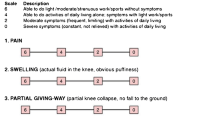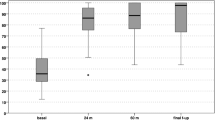Abstract
Purpose
Subchondral bone edema is a common finding after cartilage treatment, but its interpretation is still debated. The aim of this study is to analyse the presence of edema after matrix-assisted autologous chondrocyte transplantation (MACT) for knee cartilage lesions at different follow-up times and its correlation with the clinical outcome.
Methods
Two hundred and forty-eight magnetic resonance imagings (MRIs) of patients treated with a hyaluronic acid-based MACT for lesions of the knee articular surface were considered. The MRIs belonged to 116 patients (mean age at surgery 28.6 ± 10.3 years, average defect size 2.4 ± 1.0 cm2), 57 affected by degenerative cartilage lesions, 27 traumatic and 32 were osteochondritis dissecans (OCD). MRI follow-up was performed from 6 to 108 months after treatment. Other than its presence or absence, the subchondral bone edema was evaluated using a 3-level grading considering extension and hyperintensity, and with the WORMS score edema classification. The IKDC subjective score was collected at the time of every MRI.
Results
An analysis of the entire MRI group showed that edema is not constantly present through the follow-up, but presents a particular and well-defined trend. Edema was present within the first 2 years and was then markedly reduced or disappeared at 2 and 3 years (p = 0.044). Afterwards the level of edema increased again (p < 0.0005) and remained steadily present at medium/long-term follow-up. Patellar lesions presented significantly lower edema (p = 0.012), whereas OCD lesions presented more edema at all follow-up (p = 0.002) and a different trend, with an increasing level of edema over time. No correlation was found between edema and clinical outcome.
Conclusions
Edema after MACT is present during the first phases of cartilage maturation up to 2 years of follow-up, and then tends to disappear. However, after a few years, it tends to reappear. Less edema was found in the patella, whereas more edema was found in the OCD, where subchondral bone is primarily involved. Interestingly, the presence of edema was not correlated with a poorer clinical outcome. Whether this might be a prognostic factor at longer follow-up remains to be determined, but our results give some indication on what to expect on both MRI edema and clinical outcome after MACT.
Level of evidence
Case series, Level IV.



Similar content being viewed by others
References
Alparslan L, Minas T, Winalski CS (2001) Magnetic resonance imaging of autologous chondrocyte implantation. Semin Ultrasound CT MR 22(4):341–351
Behrens P, Bitter T, Kurz B, Russlies M (2006) Matrix-associated autologous chondrocyte transplantation/implantation (MACT/MACI)—5-year follow-up. Knee 13(3):194–202
Breer S, Oheim R, Krause M, Marshall RP, Amling M, Barvencik F (2013) Spontaneous osteonecrosis of the knee (SONK). Knee Surg Sports Traumatol Arthrosc 21(2):340–345
de Windt TS, Welsch GH, Brittberg M, Vonk LA, Marlovits S, Trattnig S, Saris DB (2013) Is magnetic resonance imaging reliable in predicting clinical outcome after articular cartilage repair of the knee? A systematic review and meta-analysis. Am J Sports Med 41(7):1695–1702
Dhollander AA, Huysse WC, Verdonk PC, Verstraete KL, Verdonk R, Verbruggen G, Almqvist KF (2010) MRI evaluation of a new scaffold-based allogenic chondrocyte implantation for cartilage repair. Eur J Radiol 75(1):72–81
Ebert JR, Robertson WB, Woodhouse J, Fallon M, Zheng MH, Ackland T, Wood DJ (2011) Clinical and magnetic resonance imaging-based outcomes to 5 years after matrix-induced autologous chondrocyte implantation to address articular cartilage defects in the knee. Am J Sports Med 39(4):753–763
Erggelet C, Sittinger M, Lahm A (2003) The arthroscopic implantation of autologous chondrocytes for the treatment of full-thickness cartilage defects of the knee joint. Arthroscopy 19(1):108–110
Ferruzzi A, Buda R, Faldini C, Vannini F, Di Caprio F, Luciani D, Giannini S (2008) Autologous chondrocyte implantation in the knee joint: open compared with arthroscopic technique. Comparison at a minimum follow-up of five years. J Bone Joint Surg Am 90(4):90–101
Filardo G, Kon E, Berruto M, Di Martino A, Patella S, Marcheggiani Muccioli GM, Zaffagnini S, Marcacci M (2012) Arthroscopic second generation autologous chondrocytes implantation associated with bone grafting for the treatment of knee osteochondritis dissecans: results at 6 years. Knee 19(5):658–663
Filardo G, Kon E, Di Martino A, Iacono F, Marcacci M (2011) Arthroscopic second-generation autologous chondrocyte implantation: a prospective 7-year follow-up study. Am J Sports Med 39(10):2153–2160
Filardo G, Kon E, Di Martino A, Patella S, Altadonna G, Balboni F, Bragonzoni L, Visani A, Marcacci M (2012) Second-generation arthroscopic autologous chondrocyte implantation for the treatment of degenerative cartilage lesions. Knee Surg Sports Traumatol Arthrosc 20(9):1704–1713
Filardo G, Kon E, Roffi A, Di Martino A, Marcacci M (2013) Scaffold-based repair for cartilage healing: a systematic review and technical note. Arthroscopy 29(1):174–186
Genovese E, Ronga M, Angeretti MG, Novario R, Leonardi A, Albrizio M, Callegari L, Fugazzola C (2011) Matrix-induced autologous chondrocyte implantation of the knee: mid-term and long-term follow-up by MR arthrography. Skeletal Radiol 40(1):47–56
Glenn RE Jr, McCarty EC, Potter HG, Juliao SF, Gordon JD, Spindler KP (2006) Comparison of fresh osteochondral autografts and allografts: a canine model. Am J Sports Med 34(7):1084–1093
Henderson I, Francisco R, Oakes B, Cameron J (2005) Autologous chondrocyte implantation for treatment of focal chondral defects of the knee—a clinical, arthroscopic, MRI and histologic evaluation at 2 years. Knee 12(3):209–216
Henderson IJ, Tuy B, Connell D, Oakes B, Hettwer WH (2003) Prospective clinical study of autologous chondrocyte implantation and correlation with MRI at three and 12 months. J Bone Joint Surg Br 85(7):1060–1066
ICRS (2000) Cartilage injury evaluation package. http://www.cartilage.org/Evaluation_Package/ICRS_Evaluation.pdf
Kijowski R, Stanton P, Fine J, De Smet A (2006) Subchondral bone marrow edema in patients with degeneration of the articular cartilage of the knee joint. Radiology 238(3):943–949
Kon E, Di Martino A, Filardo G, Tetta C, Busacca M, Iacono F, Delcogliano M, Albisinni U, Marcacci M (2011) Second-generation autologous chondrocyte transplantation: MRI findings and clinical correlations at a minimum 5-year follow-up. Eur J Radiol 79(3):382–388
Kon E, Filardo G, Condello V, Collarile M, Di Martino A, Zorzi C, Marcacci M (2011) Second-generation autologous chondrocyte implantation: results in patients older than 40 years. Am J Sports Med 39(8):1668–1675
Kon E, Filardo G, Di Martino A, Marcacci M (2012) ACI and MACI. J Knee Surg 25(1):17–22
Marlovits S, Aldrian S, Wondrasch B, Zak L, Albrecht C, Welsch G, Trattnig S (2012) Clinical and radiological outcomes 5 years after matrix-induced autologous chondrocyte implantation in patients with symptomatic, traumatic chondral defects. Am J Sports Med 40(10):2273–2280
Marlovits S, Mamisch TC, Vekszler G, Resinger C, Trattnig S (2008) Magnetic resonance imaging for diagnosis and assessment of cartilage defect repairs. Injury 39(Suppl 1):S13–S25
Marlovits S, Singer P, Zeller P, Mandl I, Haller J, Trattnig S (2006) Magnetic resonance observation of cartilage repair tissue (MOCART) for the evaluation of autologous chondrocyte transplantation: determination of interobserver variability and correlation to clinical outcome after 2 years. Eur J Radiol 57(1):16–23
Marlovits S, Striessnig G, Resinger CT, Aldrian SM, Vecsei V, Imhof H, Trattnig S (2004) Definition of pertinent parameters for the evaluation of articular cartilage repair tissue with high-resolution magnetic resonance imaging. Eur J Radiol 52(3):310–319
Neogi T (2012) Clinical significance of bone changes in osteoarthritis. Ther Adv Musculoskelet Dis 4(4):259–267
Obradovic B, Martin I, Freed LE, Vunjak-Novakovic G (2001) Bioreactor studies of natural and tissue engineered cartilage. Ortop Traumatol Rehabil 3(2):181–189
Pape D, Filardo G, Kon E, van Dijk CN, Madry H (2010) Disease-specific clinical problems associated with the subchondral bone. Knee Surg Sports Traumatol Arthrosc 18(4):448–462
Peterfy CG, Guermazi A, Zaim S, Tirman PF, Miaux Y, White D, Kothari M, Lu Y, Fye K, Zhao S, Genant HK (2004) Whole-Organ Magnetic Resonance Imaging Score (WORMS) of the knee in osteoarthritis. Osteoarthr Cartil 12(3):177–190
Peterson L, Vasiliadis HS, Brittberg M, Lindahl A (2010) Autologous chondrocyte implantation: a long-term follow-up. Am J Sports Med 38(6):1117–1124
Qian Y, Williams AA, Chu CR, Boada FE (2012) High-resolution ultrashort echo time (UTE) imaging on human knee with AWSOS sequence at 3.0 T. J Magn Reson Imaging 35(1):204–210
Roberts S, McCall IW, Darby AJ, Menage J, Evans H, Harrison PE, Richardson JB (2003) Autologous chondrocyte implantation for cartilage repair: monitoring its success by magnetic resonance imaging and histology. Arthritis Res Ther 5(1):R60–R73
Saris DB, Vanlauwe J, Victor J, Haspl M, Bohnsack M, Fortems Y, Vandekerckhove B, Almqvist KF, Claes T, Handelberg F, Lagae K, van der Bauwhede J, Vandenneucker H, Yang KG, Jelic M, Verdonk R, Veulemans N, Bellemans J, Luyten FP (2008) Characterized chondrocyte implantation results in better structural repair when treating symptomatic cartilage defects of the knee in a randomized controlled trial versus microfracture. Am J Sports Med 36(2):235–246
Takahashi T, Tins B, McCall IW, Richardson JB, Takagi K, Ashton K (2006) MR appearance of autologous chondrocyte implantation in the knee: correlation with the knee features and clinical outcome. Skeletal Radiol 35(1):16–26
Tins BJ, McCall IW, Takahashi T, Cassar-Pullicino V, Roberts S, Ashton B, Richardson J (2005) Autologous chondrocyte implantation in knee joint: MR imaging and histologic features at 1-year follow-up. Radiology 234(2):501–508
Trattnig S, Pinker K, Krestan C, Plank C, Millington S, Marlovits S (2006) Matrix-based autologous chondrocyte implantation for cartilage repair with HyalograftC: two-year follow-up by magnetic resonance imaging. Eur J Radiol 57(1):9–15
Vasiliadis HS, Danielson B, Ljungberg M, McKeon B, Lindahl A, Peterson L (2010) Autologous chondrocyte implantation in cartilage lesions of the knee: long-term evaluation with magnetic resonance imaging and delayed gadolinium-enhanced magnetic resonance imaging technique. Am J Sports Med 38(5):943–949
Ventura A, Memeo A, Borgo E, Terzaghi C, Legnani C, Albisetti W (2012) Repair of osteochondral lesions in the knee by chondrocyte implantation using the MACI(R) technique. Knee Surg Sports Traumatol Arthrosc 20(1):121–126
Acknowledgments
B. Di Matteo, G. Altadonna, L. Andriolo, S. Bassini, E. Ferretti: II Clinic, Biomechanics Laboratory, Rizzoli Orthopaedic Institute, Bologna, Italy. E. Pignotti, K. Smith: Task Force, Rizzoli Orthopaedic Institute, Bologna, Italy. The research leading to these results has received funding from the European Union’s Seventh Framework Programme (FP/2007-2013) under grant agreement number 278807.
Author information
Authors and Affiliations
Corresponding author
Rights and permissions
About this article
Cite this article
Filardo, G., Kon, E., Di Martino, A. et al. Is the clinical outcome after cartilage treatment affected by subchondral bone edema?. Knee Surg Sports Traumatol Arthrosc 22, 1337–1344 (2014). https://doi.org/10.1007/s00167-013-2813-4
Received:
Accepted:
Published:
Issue Date:
DOI: https://doi.org/10.1007/s00167-013-2813-4




